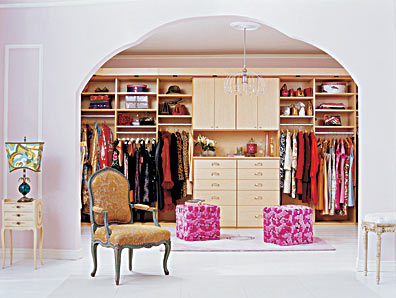Hopefully you’ve managed to do a thorough closet cleanup and gotten as far as the first part of closet organization. All that remains is to give your closet a system. Regardless of the space you have available, the guidelines below should help you get organized:
- Clothes, shoes and accessories only – try not to clutter your closet with all sorts of other items. The aim is to create a concise and efficient dressing area so that you can shop in your own closet every morning.
- Hanging space – assign each item of clothing to its correct hanger and group your hangers by category (e.g. group all shirts together, then all knitted tops together, and so on)
- Dresses, jackets, blouses, shirts should be hung on a simple wooden or thick plastic hanger
- Skirts should be hung on clip hangers
- Suits, pants, slacks, jeans and shorts should be hung on suit hangers
- Fancy knitted tops and knitwear should be hung on padded hangers
- Heavy coats and jackets are best hung on shaped hangers
- Shelving – fold and stack knitted tops, t-shirts, pullovers and sweatshirts into separate piles.
- Underwear, camisoles, socks and tights –fold and section each category into drawers using drawer dividers.
- Sleepwear – fold and place into a separate drawer or area in your walk in wardrobe.
- Sports gear – work out clothes, ski clothes, cycling togs, soccer kit or any other type of sports gear needs to be folded and kept in a separate drawer or shelf. These items should not be worn as everyday clothing unless you are actually engaging in the sport. If you keep them close to the rest of your clothing, you’ll be tempted to wear them day to day and that’s not stylish.
- Belts and long necklaces – hanging them on a tie rack makes them easy to access. Alternatively, hammering a small nail into a cupboard door for each separate accessory will also do the trick.
- Handbags – if you do not have a separate cupboard for your bags – placing them on shelves will also work. Messenger bags are best hung on hooks, while dainty evening bags and clutches are best filed side by side or stacked in a drawer.
- Shoes – shoes need to be stored either on shoe racks or in canvas shoe files. If you do not have room to keep your shoes in your closet underneath your hanging space, then in the coat closet close to the front door is also a good idea.
- Scarves, hats, gloves and shawls – fold and stack these into boxes or baskets in your closet. If you have a large assortment, then group each category into its own separate box. These items are very seasonal and proper storage will keep them free from dust and moths.
- Jewelry – everyone has their own personal storage vessel for their jewelry. Whatever you select needs to be easy to access and kept dust free. There is little point in storing everyday jewelry far away from your clothes – you’ll forget all about them when it comes to dressing. Keep your accessory boxes organized – if your jewelry is tangled, you won’t wear it.
You will still be able to use the above closet system if you share a wardrobe with someone else. For the ultra regimented, consider sorting your clothes not only by category, but by colour – it not only makes your closet look even more inviting – but it makes it even simpler when putting together your look for the day.
With a little organization, even those of us with modest closets will be able to experience some of the benefits of a very fancy, custom California Closet like the one above.
